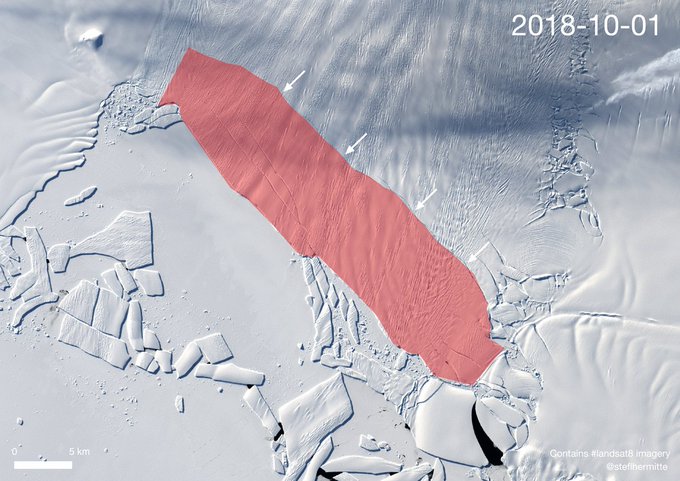“Huge Iceberg Poised to Break Off Antarctica's Pine Island Glacier” (Oct. 9, 2018)
Margo
reviews two articles from today that cover the potential calving of
Pine Island Glacier and shows how to find it on NASA Worldview.
Time
is short - get your spiritual houses in order. God bless everyone.
Power to the Truth!
Peace,
Margo
Show
Links:


Satellite images showing the Pine Island Glacier on Sept. 17, 2018 and Oct. 1, 2018.
Credit: Landsat OLI imagery processed by Stef Lhermitte/Delft University of Technology
A
newly discovered long and craggy rift is splintering across West
Antarctica's Pine Island Glacier, satellite images
show.
The
nearly 19-mile-long (30 kilometers) rift started in the middle of the
ice shelf, where the ice shelf touches warmer ocean waters that are
melting it from underneath, said Stef Lhermitte, an assistant
professor in the Department of Geoscience and Remote Sensing at the
Delft University of Technology in the Netherlands.
The rift only has about
another 6 miles (10 km) to go before one or more icebergs calf,
breaking off from the glacier, Lhermitte said. Another such event
happened a mere year ago in 2017, when an iceberg 4.5 times the size
of Manhattan broke off Pine Island Glacier. [Photo
Gallery: Antarctica's Pine Island Glacier Cracks]


The area of the upcoming Pine Island Glacier is about 115 square miles (300 square kilometers).
Credit: Landsat OLI imagery processed by Stef Lhermitte/Delft University of Technology
Lhermitte
found the new crack by analyzing satellite images of the glacier,
which he receives every day in his email inbox. "It was
Wednesday evening [Oct. 3] and all of a sudden I saw something I
didn't see the day before," he told Live Science.
If the iceberg breaks off
in one piece, it will be a whopping 115 square miles (300 square
kilometers), which is even larger than the one
that broke off last year.
(The 2017 iceberg was 103 square miles, or 267 square km.)
If
the resulting iceberg is large enough, it will receive a name,
Lhermitte noted. But, regardless of whether the crack leads to one or
many icebergs, this will be the sixth large-calving event
that Pine Island Glacier has experienced since 2001,
he said.
Granted,
it's natural for a glacier to calf icebergs. But what's concerning
about Pine Island Glacier is that it's calving
icebergs more frequently than it used to, Lhermitte
said. Pine Island Glacier birthed icebergs in January
2001, November 2007, December 2011, August 2015 and September 2017.

The red line shows where the 2017 Pine Island Glacier iceberg broke off. The blue line shows the newfound rift.
Credit: Landsat OLI imagery processed by Stef Lhermitte/Delft University of Technology
The
upcoming iceberg isn't loose yet, "but the fact that the rift is
almost across the entire glacier, it might happen relatively soon,"
Lhermitte said.
It's
challenging, however, to say what "soon" means. According
to Lhermitte, the calving event will likely happen in a matter of
weeks or months, "but it probably won't take years," he
said. "I expect this to happen from now to sometime this
Antarctic summer."
Once
the breakage happens, the iceberg will likely stay frozen if it hangs
out with the sea ice in the Antarctic. But if ocean currents carry it
farther north, the iceberg will melt in the warmer waters, Lhermitte
said.
Pine Island Glacier
is one of the fastest flowing glaciers in Antarctica. Every year, it
loses 45 billion tons (40.8 billion metric tons) of ice, which in
turn causes sea levels to rise 0.03 inches (1 millimeter) every eight
years, The
Washington Post reported last year.
Sea levels would rise 1.7 feet (0.5 m) if the entire glacier melted.
This
video, which runs from 2002 to 2016, depicts just how much ice Pine
Island Glacier is losing. (In the video, the colors yellow, orange,
red and black represent ice loss, while blue indicates ice gain.)
Ice
shelves are important because — like dirt clogging a sink that
slows the drain of water — they impede the glacier from flowing
full force out into the ocean, Lhermitte said. Once the upcoming
calving event happens, Pine Island Glacier will have
retreated nearly 4 miles (6 km), Lhermitte wrote
on Twitter.
As
for why Pine Island Glacier is losing more of its ice
shelf (the icy portion that doesn't touch the bedrock, but extends
over the ocean), it's hard to say. The warm water that is melting the
ice shelf from underneath was pushed up from the deep ocean,
Lhermitte said.
"The
reason why we get this upwelling of warm water is certainly climate
related, but it's very difficult to say if this is climate change
related," he said. "Antarctica is a very sensitive
continent for climate change. But for this individual iceberg, this
is impossible to infer."




No comments:
Post a Comment
Note: only a member of this blog may post a comment.